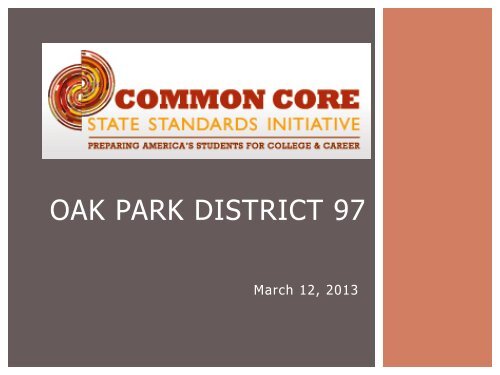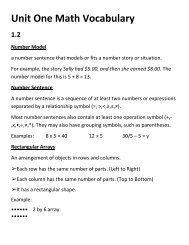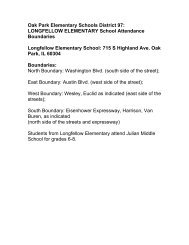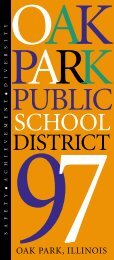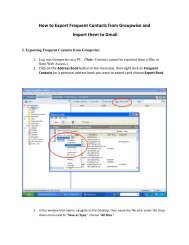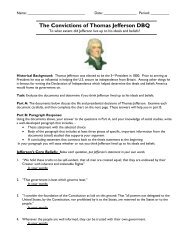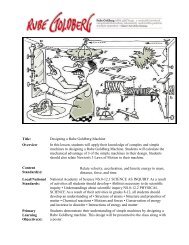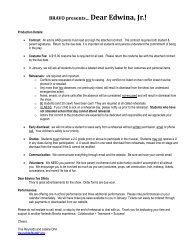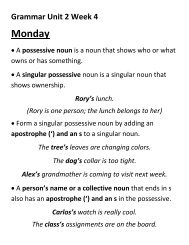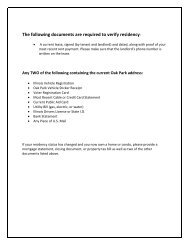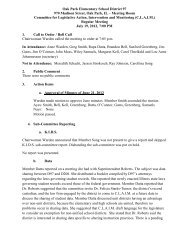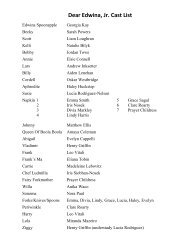Common Core State Standards - Oak Park Elementary School ...
Common Core State Standards - Oak Park Elementary School ...
Common Core State Standards - Oak Park Elementary School ...
Create successful ePaper yourself
Turn your PDF publications into a flip-book with our unique Google optimized e-Paper software.
OAK PARK DISTRICT 97<br />
March 12, 2013
CCSS…. WHY NOW?<br />
The <strong>Common</strong> <strong>Core</strong> <strong>State</strong> <strong>Standards</strong> Initiative<br />
is a state-led effort coordinated by the National<br />
Governors Association (NGA) and the Council of<br />
Chief <strong>State</strong> <strong>School</strong> Officers (CCSSO).<br />
¡ Disparate standards across states<br />
¡ Student mobility<br />
¡ Global competition<br />
¡ Today’s jobs require different skills
Why is this important for<br />
students, teachers, and parents?<br />
¡ Prepares students with the knowledge<br />
and skills they need to succeed in<br />
college and work<br />
¡ Ensures consistent expectations<br />
regardless of a student’s zip code<br />
¡ Provides educators, parents, and<br />
students with clear, focused guideposts
The <strong>Standards</strong> are……<br />
¡ Fewer, clearer, and higher, to best drive<br />
effective policy and practice;<br />
¡ Aligned with college and work expectations, so<br />
that all students are prepared for success upon<br />
graduating from high school;<br />
¡ Inclusive of rigorous content and application of<br />
knowledge through high-order skills, so that all<br />
students are prepared for the 21 st century;<br />
¡ Internationally benchmarked, so that all<br />
students are prepared for succeeding in our global<br />
economy and society; and<br />
¡ Research and evidence-based.
English Language Arts (ELA) <strong>Standards</strong><br />
College and Career Readiness (CCR) <strong>Standards</strong><br />
§ Overarching standards<br />
Grade-Level <strong>Standards</strong> in English Language Arts<br />
§ K-8, grade-by-grade<br />
§ Four strands: Reading, Writing, Speaking and<br />
Listening, and Language<br />
<strong>Standards</strong> for Literacy in Social Studies and Science<br />
§ <strong>Standards</strong> are embedded at grades K-5<br />
§ Content-specific literacy standards are provided<br />
for grades 6-8, 9-10, and 11-12
Research-Based<br />
The <strong>Common</strong> <strong>Core</strong> is in part a response to the<br />
steady decline in the complexity of texts<br />
over the last 50 years in US schools.<br />
Chall & Colleagues<br />
Harvard University
ELA <strong>Standards</strong><br />
¡ All students must be able to<br />
comprehend texts of steadily<br />
increasing complexity as they<br />
progress through school.<br />
¡ The complexity of what students<br />
read matters.
Literature/Informational Text<br />
Grade<br />
Level<br />
Literature<br />
Informational Text<br />
4 th 50% 50%<br />
8th 45% 55%<br />
12th 30% 70%
Six Shifts in the ELA <strong>Standards</strong><br />
¡ Read as much non-fiction as fiction<br />
¡ Help your child learn about the world by<br />
reading<br />
¡ Read more challenging material<br />
¡ Discuss reading and ask for evidence from<br />
your child from the text<br />
¡ Write non-fiction<br />
¡ Increase use of “academic” vocabulary
Mathematics<br />
Focus strongly where the <strong>Standards</strong><br />
focus<br />
Coherence: Think across grades, and<br />
link to major topics within grades<br />
Rigor: Require fluency, application,<br />
and deep understanding
Mathematics <strong>Standards</strong><br />
<strong>Standards</strong> for Mathematical Content<br />
§ K-8 grade-by-grade standards organized by<br />
domain<br />
<strong>Standards</strong> for Mathematical Practice<br />
§ Describe mathematical “habits of mind”<br />
§ Offer standards for mathematical proficiency:<br />
reasoning, problem solving, modeling, decision<br />
making, and engagement<br />
§ Connect with content standards in each grade
Eight <strong>Standards</strong><br />
for Mathematical Practice<br />
1. Make sense of<br />
problems and persevere<br />
in solving them.<br />
2. Reason abstractly and<br />
quantitatively.<br />
3. Construct viable<br />
arguments and critique<br />
the reasoning of others.<br />
4. Model with<br />
mathematics.<br />
5. Use appropriate tools<br />
strategically.<br />
6. Attend to precision.<br />
7. Look for and make use<br />
of structure.<br />
8. Look for and express<br />
regularity in repeated<br />
reasoning.
Sample CCSS 4 th Grade Math Problem
Six Shifts in the Math <strong>Standards</strong><br />
¡ Focus – learn about fewer, key topics<br />
¡ Keep building on learning year after<br />
year<br />
¡ Developing speed and accuracy<br />
¡ Understand why math works and be<br />
able to prove it<br />
¡ Apply math in real world situations<br />
¡ Think fast and solve problems
The Imperative<br />
¡ Our new <strong>Common</strong> <strong>Core</strong> <strong>Standards</strong> will<br />
challenge us to move beyond recall of<br />
facts.<br />
¡ We will be challenged to assess<br />
student learning in more complex and<br />
multi-dimensional ways.<br />
¡ We will also be challenged to infuse<br />
more cognitive complexity into the<br />
knowledge-acquisition process.<br />
(Conley, 2011)
The Partnership for Assessment of<br />
Readiness for College and Careers:<br />
§ Made up of 22 states<br />
§ Charged with developing high-quality<br />
math and English language arts tests for<br />
grades 3–11<br />
§ Computer-based and linked to what students<br />
need to know for college and careers<br />
§ Implementation in 2014–15 school year
PARCC Priorities<br />
1. Determine whether students are college and<br />
career ready or on track<br />
17<br />
2. Connect to the <strong>Common</strong> <strong>Core</strong> <strong>State</strong> <strong>Standards</strong><br />
3. Measure the full range of student<br />
performance, including that of high- and lowachieving<br />
students<br />
4. Provide educators data throughout the year to<br />
inform instruction<br />
5. Create innovative 21st century, technologybased<br />
assessments<br />
6. Be affordable and sustainable
How will PARCC be different?<br />
Students: Will know if they are on track<br />
to graduate ready for college/careers<br />
Teachers: Will have access to timely data to<br />
guide learning and instruction<br />
Parents: Will have clear and timely<br />
information about student progress<br />
<strong>State</strong>s: Will have valid results that are<br />
comparable across borders
COMMON CORE<br />
Irony: It is not about being<br />
“common” or “ordinary”
It is about….<br />
Being EXTRAORDINARY!
For more information<br />
¡ www.op97.org<br />
§ National PTA <strong>Common</strong> <strong>Core</strong> Parent Guides<br />
§ Parent Roadmaps from the Council of Great City<br />
<strong>School</strong>s<br />
¡ <strong>Common</strong> <strong>Core</strong> <strong>State</strong> <strong>Standards</strong><br />
§ http://www.corestandards.org/<br />
¡ PARCC - Partnership for Readiness for College and<br />
Careers<br />
§ http://www.parcconline.org


